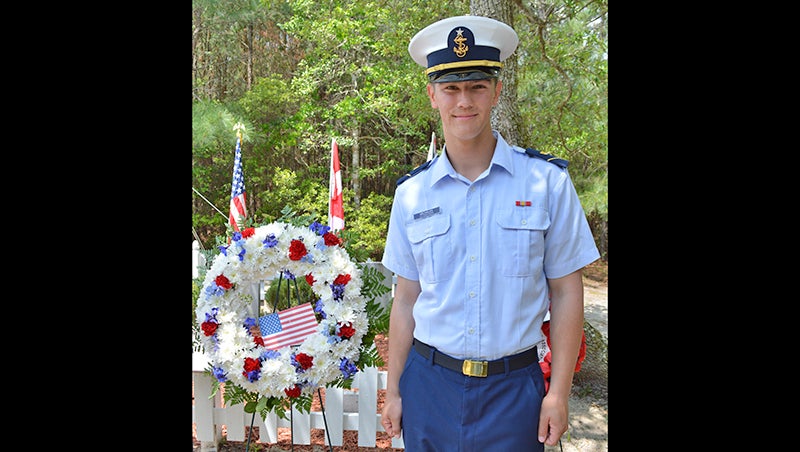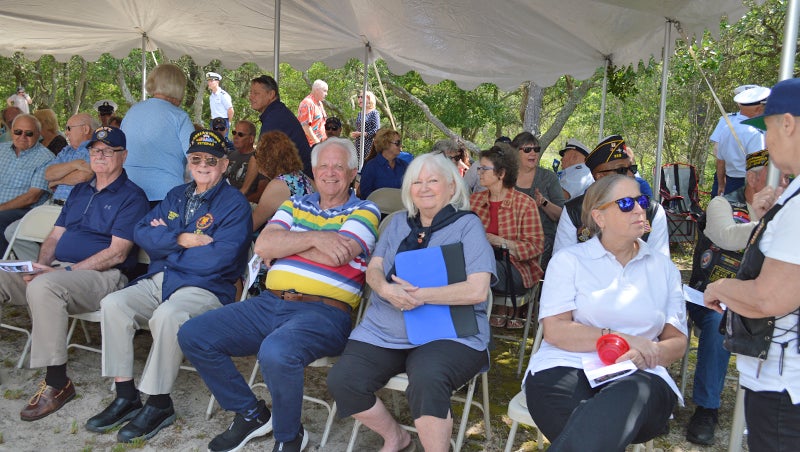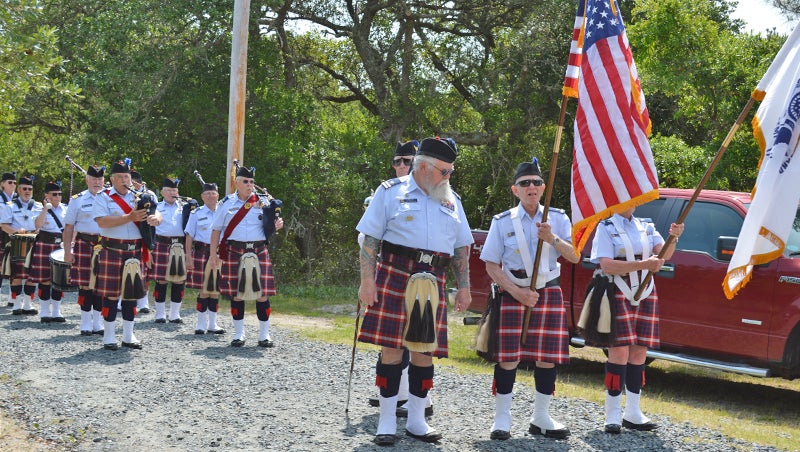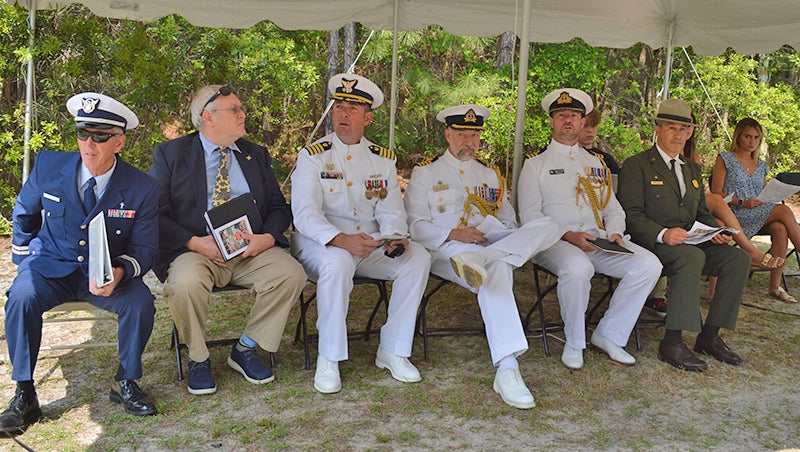Buxton British Cemetery ceremony draws crowd
Published 4:06 pm Monday, May 22, 2023
|
Getting your Trinity Audio player ready...
|
Weather was perfect on May 11, 2023 for the British Cemetery Memorial Service in Buxton.
The sun shone brightly highlighting white dress uniforms. A very light breeze slipped through surrounding trees in the Cape Hatteras Lighthouse District.
A large crowd gathered, sitting under and standing around a canopy. Last year, the weather was not so hospitable.
Dignitaries, a large U.S. Coast Guard contingent, National Park Service officials, Cape Hatteras Secondary students and public members are pulled together annually to remember.
Remember that young men on a British merchant marine oil tanker were killed April 9, 1942, by a torpedo from a German submarine U-203.
Two bodies came to rest on Hatteras Island beaches. Fourth Engineer Officer Michael Cairns of The Royal Merchant Navy was 28. The other gravestone is to an unknown sailor. The buried one could be Able Seaman Ernes Kelly, age 20, of Middlesborough, England, or Able Seaman John White, age 19, of Haddington, Scotland. Hatteras Islanders gave those sons a proper burial.
“May we remember today that young men from our faithful ally and friends across the sea came to defend the shores of our nation against a demonic darkness,” prayed Rev. Billy Rutledge at the invocation.
Remarks followed from officials representing three countries:
David Hallac, superintendent of the National Parks in Eastern North Carolina, oversees the Cape Hatteras National Seashore, America’s first national seashore. He reminded the gathering of the seashore’s history with a naval station in Buxton, of a Coast Guard station, of the Cape Hatteras lighthouse and the shipwrecks off the shores.
Commander Derek Powles represented the British Navy. 1942 was brutal for merchant ships. In January, 12 merchant ships were lost; in February, nine; in March, 26; and in April, 20.
About the two men in the graveyard, Powles said, “After 81 years, they are among people who care.”
Captain Bill Quinn, the Canadian Naval attaché, Canadian Embassy, said as a child he laid a wreath on the grave of his grandfather, who was killed by a submarine. He placed a wreath on May 11 to remember two who died in 1942.
U.S. Coast Guard Sector Commander Capt. Matthew Baer also had a grandfather in World War II. His grandfather was shipwrecked three times. Of the U.S. Coast Guard, Baer said “we continue our lifesaving legacy” and heritage of saving lives at sea.
Danny Couch, president of the Friends of the Graveyard of Atlantic Museum, reminded the gathering that in the 1990s the graveyard was cleaned and a small ceremony memorized the sailors of the San Delfino.
The history of the San Delfino was presented by Cape Hatteras Secondary School senior Chloe Flythe and senior Shayley Ballance intoned the names and ages of all those who died on April 9, 1942.
Wreaths were placed in front of the white picket fence surrounding the grave site. As is tradition, the youngest member of the U.S. Coast Guard stationed at Hatteras Inlet Lifeboat Station places the wreath for the U.S. Coast Guard. On this his 19th birthday, Third Class Cadet Tyler Michalek, from Dallas, Texas, placed the wreath. Michalek is in his sophomore year at the U.S Coast Guard Academy in New London, Conn., and is stationed at Hatteras Inlet for five weeks as his summer assignment.
After the benediction, a salute was fired by a contingent from U.S. Coast Guard Station Hatteras. Then, Gideon Couch, another student from Cape Hatteras Secondary, sounded the Last Post and the United States Pipe Band, Coast Guard Auxiliary, piped honors.
A ceremony of Blending Waters by American Legion representatives from Fredericksburg, Va. concluded the memorial service.
The Friends of the Graveyard of the Atlantic Museum, U.S. Coast Guard, Flotilla 16-04 Coast Guard Auxiliary and the National Park Service hosted the event. Lt. Cory D. Woods, supervisor of the Marine Safety Detachment in Nags Head, presided over the service.
After the ceremony, a luncheon was held in the parish hall at Our Lady of the Seas Catholic Church in Buxton.
British merchant vessel San Delfino
During the first six months of 1942, U-Boats hunted along the world’s busiest sea lanes hard by New York, Cape Hatteras and Florida and efficiently sunk nearly 400 largely unescorted merchant vessels and stemmed the delivery of badly needed food and war material to England. The armed tanker San Delfino was one of the vessels lost.
The San Delfino was an 8,000 ton oil tanker registered in England and owned by the Eagle Oil Shipping Company, located at 16 Finsbury Circus, London. She was built in 1938, was 479 feet long, 61 feet in the beam, and had a draft of 27 feet. Designated as a defensively equipped merchant ship, she was armed with one four-inch gun, one 1216 anti-aircraft gun, four .30 caliber machine guns, two .303 caliber Hotchkiss machine gun and a Lewis gun. She was powered by twin diesels and had a service speed of 12 knots. Her cargo consisted of 11,000 tons of aviation fuel and an undisclosed amount of small arms ammunition. The tanker was on route from Houston, Texas, to England, via New York and Halifax, where she would join a convoy for the transatlantic crossing.
At 10 p.m. on April 9, 1942, off Pea Island, North Carolina, at 35 degrees, 35 minutes north, 75 degrees, 6 minutes west, despite four lookouts, a blackout, and a zigzag course, a single torpedo, fired from the U-203 under the command of Kapitanleutnant Mutzelberg tore out San Delfino’s starboard side near the number 2 or number 3 tank.
The ship erupted in a sheet of flame. Secondary explosions of fuel and ammunition turned the vessel into a fiery derelict. Captain Gumbleton instantly ordered abandon ship. Two lifeboats were lowered. One, with 28 men, was drawn into the fuel-fed inferno. The other, with 21 men, escaped destruction and was later picked up by Captain Cornelius Sanders and the trawler Two Sisters, which was enrolled as a “confidential observer” for the United States Navy.
Nearly a month after the attack, the remains of Fourth Engineer Officer Michael Cairns of the Royal Merchant Navy were discovered on the shore of Hatteras Island. Two weeks later, the remains of an unknown sailor of the Royal Navy washed up on the Hatteras beach. This could have been either Able Seaman Ernest Kelly, age 20, of Middlesborough, England or Able Seaman John White, age 19, of Haddington, Scotland. They were the only two Royal Navy gunners aboard San Delfino at the time.
The body of John Latto Fisher, age 25, of Edinburgh, Scotland was found farther to the south and is interred in Morehead City (Bay View) Cemetery.
M.V. San Delfino Roll Of Honor
- GEORGE ALLEN, Ordinary Seaman, age 20
- MALCOM ALLEN, Mess Room Boy, age 17
- GUISEPPE BORIN, Junior Engineer Officer, age 35
- ANGUS BEVERIDGE BRUCE, Sailor, age 29
- ROBERT CUMMINGS BRUCE, Pumpman, age 29
- JOHN HUME BUNYAN, Able Seaman, age 32
- MICHAEL CAIRNS, Fourth Engineer Officer, age 28
- ARHIBALD CONNACHIE, Ordinary Seaman, age 16
- LESLIE CRAWFORD, Greaser, age 29
- JOHN CROSS, Cook, age 25
- JOHN LATTO FISHER, Sailor, age 25
- JOHN GRANT, Greaser, age 50
- WILLIAM GRAY, Steward, age 21
- JOHN KEENAN, Storekeeper, age 37
- ERNEST RAYMOND KELLY, Royal Navy Gunner, age 20
- ADOLF MICHAEL MICHELSON, Carpenter, age 58
- GEORGE HENRY DAVID MITCHELL, Bosun, age 36
- ALEXANDER COOK PATTERSON, Fireman, age 24
- HENRY PEAKMAN, Pumpman, age 46
- RICHARD PICKEN, Fireman, age 43
- WILLIAM REID RICHARDS, Sailor, age 21
- JAMES ANDREW ROBERTSON, Greaser, age 51
- FRANCIS SHAW, Sailor, age 17
- GEORGE TURNBULL, Fourth Engineer Officer, age 22
- JAMES ROBINSON WATT, Able Seaman, age 25
- JOHN WHITE, Royal Navy Gunner, age 19
SUBSCRIBE TO THE COASTLAND TIMES TODAY!










